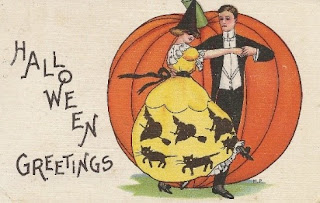We hope you will enjoy this four-part blog post which continues the story of this spellbinding holiday.
Part I: Gilded Hallowe’en -- 1890-1916
By the 1890s, Halloween had captured the hearts and imaginations of Americans from coast to coast, in cities, towns and countryside. Regardless of social standing, young and old alike embraced Halloween merry-making in many forms.
Various industries and businesses developed unique products contributing to the commercialization and spread of the holiday. Halloween postcards printed in Germany, England and the U.S. were an inexpensive way to send cheery (or scary) greetings to friends and loved ones across the miles, or invite them to a party next door.
The savvy hostess could consult special Halloween guidebooks to plan her party if the array of newspaper and magazine articles was not sufficient to provide ideas for a unique presentation. Decorations and novelties were essential to transform the home or hall into a vision of jollity and mystery, with a good measure of the grotesque. Jack O’ Lantern pumpkins, witches, ghosts, black cats, owls and bats were the most usual themes with elves, sprites, devils or skeletons making appearances.
 |
| Hallowe’en—How to Celebrate It, by Martha Russell Orne, 1898, Courtesy Worthpoint |
 |
| Dennison Manufacturing Company advertising card, 1905, Courtesy vintagehalloweencollector.com |
 |
| Dennison’s crepe paper sample c. 1913-1914, Courtesy Smithsonian Institution |
Nuts and apples were requisite for refreshments as well as for the Halloween games that would be played as had been done for generations. Young ladies were especially fond of the rituals portending romance. As family and friends gathered together on Halloween night, pumpkins would be carved, apples bobbed for, fortunes told, and ghost stories whispered in flickering firelight.
Halloween menus ran the gamut from cider and doughnuts to Lobster Newburg, all served in whimsical ways. Candy was essential, whether homemade or store-bought, and packed in fanciful figural containers.
The centerpiece of the table would be a cleverly decorated Halloween cake (likely a sinfully rich chocolate Devil’s Food) with fortune-telling trinkets baked inside. Who will be married? Who will remain a spinster? Who will be rich?

 |
| Pumpkin man candy container, German, Courtesy liveauctioneers.com |
“And music, there must be music” at the Halloween party! A Victrola record player was what you needed to listen to a violin’s ghostly strains or dance a waltz or foxtrot.
 |
| Brooklyn Daily Eagle, 19 Oct 1916 |
There was not yet “trick-or-treat” as we know it, however children paraded in the streets wearing false face masks and costumes on their way to parties. Little witches, goblins and clowns carried hollowed-out pumpkins or figural papier-mâché lanterns to guide them.
 |
| Philadelphia Inquirer, 31 Oct 1902 |
 |
| Halloween costume 1916 |
Mischievous boys played pranks-- stealing gates, ringing doorbells, soaping windows, or throwing bags of flour at passers-by. These antics increasingly became a nuisance but were part of the holiday, anticipated with glee by the perpetrators while dreaded by property owners and local authorities.
 |
| Courtesy halloween.lisamorton.com |
For the country club set, Halloween was the official start of the winter social season. Elegant Halloween gowns for the autumn dances were in white or soft pastels, made of satin or chiffon, with tulle or gold and silver net trimmings.
 |
| Halloween by Howard Chandler Christy, 1915 |
With Halloween such an integral part of American culture, I wondered how its observance might have been impacted by World War I and the ensuing influenza pandemic. Would the holiday continue to be celebrated, or would it be cast aside?
The First World War erupted in Europe between the Allied Powers (Great Britain, France, Italy, Russia, Japan) and the Central Powers (Germany, Austria-Hungary, Ottoman Empire) in the summer of 1914. The continent was ravaged for three years before the US entered the fight in April 1917.
From 1914 to 1916, the specter of war loomed large, but it was too distant to interfere with traditional American Halloween celebrations:
The candy shop windows in Fifth Avenue have been filled for days with black witches and grinning pumpkin faces, and there is hardly a girl in the social ranks who will not join in a jolly gathering …and at the stroke of midnight gaze into a mirror in the pale candle light in search of a fleeting glimpse of her Prince Charming, beside which the issue of battles and the fate of Kings fall into comparative insignificance. (New York Times, 25 Oct 1914)
 |
| The Evening World, New York, 28 Oct 1915 |
What was a Halloween party without novelties and favors? Unheard of! But most of these were imported from Germany—what to do? In 1915, the Loft Stores in New York City advertised “Halloween Novelties in Profusion and Abundance! No War Prices Either!” How were they able to do that? Backed by the “Power of American Gold,” Loft dispatched their own messenger to Europe bypassing importers, a long wait and high prices to get the goods to American consumers. In 1916, Loft was still “fortunate enough to have many of the cleverest German and Japanese novelties.”
“Call it grit, enterprise, or what you will,” Halloween would be jolly as ever in America--for now.
Note: Halloween postcards c. 1906-1916 are from the author’s collection unless otherwise noted.










No comments:
Post a Comment